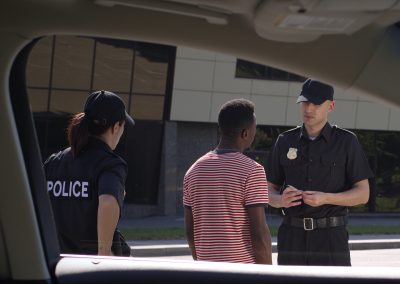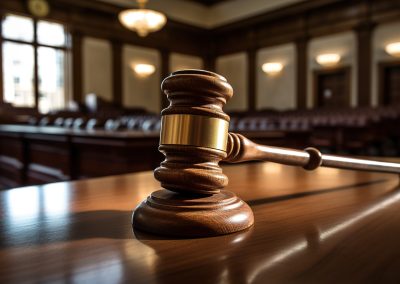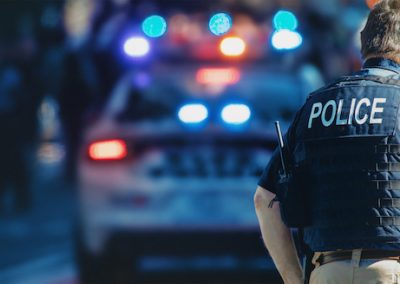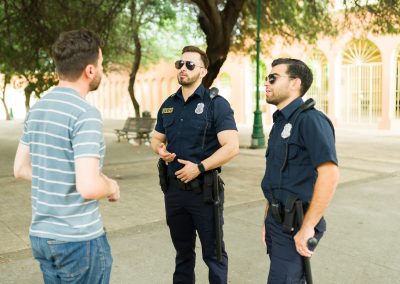In Part One, we discussed the obligations and requirements for working as a consulting expert in matters of police litigation. In this second part, we’ll discuss some of the trials (pardon the pun) and tribulations of appearing in court as a testifying expert.
Your Record, Examined
When you author a report on a case, you for the most part have disclosed your identity to other side. And the vetting will now begin …
The other side will usually spare no expense tearing apart your entire life: where you worked, your employment record, educational credentials, and any and all cases you’ve ever opined on, even if your opinion was only expressed in a report. And if you’ve testified in a deposition or trial, that transcript will be obtained and gone over with a fine-tooth comb to see if you expressed any contrary opinions. They may even contact your current or former employers to see about your employment history.
I recall one expert from the other side who listed his “steady progression of promotions,” up the ranks from patrol officer to detective to sergeant, and then lieutenant, captain and major, all the way up to deputy chief of police. However, his online biography indicated he was an “honorably retired police captain.” A little checking with a few agency sources revealed that he took a voluntary reduction in rank from deputy chief down to captain over a beef between the agency and the police union. That two-step reduction in rank never made it into his testimony at trial because the case settled, but it did find its way into the transcript during his sworn deposition.
Bottom line: When you cross the threshold from anonymous consulting expert to listed testifying expert, you’ve opened up your whole professional (and sometimes personal) life.
On Record
As soon as you publish your report, you’ve documented your opinions “for the record.” That report, along with your deposition transcript, will follow you for the duration of that case—and beyond.
And since we’re talking about depositions, the Federal Rules of Civil Procedure under Rule 26 permit an expert to be questioned for up to seven hours. I’ve been there. It takes a strong constitution to undergo that kind of cross examination. It’s not uncommon to have the first five or six hours go by and have the attorney not even touch on the facts of the case or your opinions, but instead go over your CV, your published articles, your work history, formal education, agency status, financials, all the way up to what kind of car you drove to the deposition in. Any inconsistencies between your report and that deposition will be used against you during cross examination at trial to impeach you if it in any way differs from your direct testimony.
Remember: They got seven hours of information from you during that deposition and they will use every minute of it.
Frustrations in Court
Frustrations abound during a trial. Many times, what you think are significant facts in the case may never reach the ears or eyes of the jury. Not to demean our judicial system, but I’ve been involved in trials where the judge definitely did not see the scales that Lady Justice was holding the same way I did. What I felt was relevant to how an officer perceived a threat was not how the judge saw it. And remember, under Graham v. Connor, it’s the “reasonable perception” of the threat that counts, not whether the threat was actually “present” or not.
Some judges don’t want certain words used. For example, I had a case where the officer was assaulted during the arrest, beaten senseless, but I was not allowed to refer to him as the victim. The “victim” was the plaintiff according to his Honor. Another judge did not want the jury to hear about visible gangster tattoos that the agent saw on the face and forehead of the arrestee. In his report and statements taken immediately after the arrest, the agent testified that those tats escalated (quite properly, I might add) his awareness level. In other words, he knew he was dealing with dangerous dudes. But the judge thought it was irrelevant and prejudicial to the plaintiff for the jury to hear about them, even though it was agent who was on trial.
I think the ultimate in frustration occurred during a case I testified in from Tennessee. The civil jury found in favor of the two officers who were involved in a fatal shooting of a gunman who chased an officer and was about to shoot him in the back. Fortunately, the partner officer fired first and nailed the bad guy in his back.
After the favorable verdict, the U.S. District Court judge dismissed the jury and thanked them for their service. He then went on a 30-minute rant in open court in front of the officers, their families, and the attorneys slamming the jury’s decision and actually set aside their verdict clearing the two cops. It’s called a Judgment Notwithstanding the Verdict (JNOV). Fortunately, the U.S. Court of Appeals reversed that judge’s decision, but that appeal took years.
Records Management: Next, keep in mind, even if the defense wins, the plaintiff’s can appeal. I have files on cases that have gone to trial with a successful verdict, where the other side filed notice to appeal. So your archives may not get smaller even after the trial. Speaking of archives, after you’ve been disclosed as a testifying expert, in many cases you’ll be asked to bring your entire file to the deposition. By entire file, I mean the original offense report, the IAB file, all the forensic reports, photographs, tapes, department policy statements, training records of the officers, their personnel files, any depositions from witnesses or department brass, depositions of the agency training officers, CAD logs, dispatch transcripts, all the motions, the CVs, fee schedules, expert reports and Rule 26 statements of all the other experts.
I’ve even been asked to make copies of my entire file comprised of thousands of pages and forward it to the opposing out of town attorney no later than 10 days before I’m scheduled to be deposed. Most often when I inform them of the actual copying costs to photocopy the file, my time to do it, and the cost just to mail it, they back off. But, again, just doing this adds to your office time.
Costs: Speaking of costs, your fee schedule should also reflect what you expect to get reimbursed for by your client to include expenses for lodging, meals, cab fare, and reasonable gratuities. My fee schedule requires the attorney-client to purchase and make my flight reservations. But if you chose to make your own, outline your flight requests, and whether its coach, first- or business-class. Most will only pay for coach class tickets and they’ll expect you to cover the cost of the upgrade. I only require coach class, but use my frequent flyer mileage to upgrade.
Time: Standby court time can also add to the frustration level once you’ve crossed the line from consulting expert to testifying expert. A little known fact—even to some judges—is that experts are normally not subject to the rules of sequestration. In other words, we’re allowed to listen to the witnesses, whereas fact witnesses can not.
I’ve spent days sitting in the courtroom listening to the other witnesses and experts. On the other hand, I’ve spent an equal amount of time riding the pine in the witness room when the judge granted the opposing lawyer’s sequestration request. You need to factor that standby time in your fee schedule. It’s time away from your office and your phone, and you should be compensated for it.
Cell phones: Speaking of phones, most judges will not allow an expert (or others except for on-duty police officers) to have a cell phone in the courtroom. The U.S. Marshals or Court Officers will usually take it away as you enter the courthouse. I’ve become accustomed to just leaving it in my rental car or hotel room when I go to court.
Attire: Dress for success. I know many trainers who choose to remain a consulting expert for reasons of convenience, not the related courtroom issues. They like to work from home and not be subjected to the rigors of travel to out of town sites, depositions or trials. So, along those lines, when going to court, dress like an expert would.
What that means is, look the part. A dark grey or blue suit, white or light pastel shirt with matching polished shoes, and a corresponding tie. Leave the power watches and other jewelry at home. And while depositions are usually done in an informal setting at the attorney’s office, I’ve become accustomed to dressing formally for those, too—at least in a jacket and tie—since many times they’re video recorded. If for no other reason, it might be the first time your client (the attorney who hired you) gets a chance to see how you’ll look in court.
Bottom line: Leave the golf shirt and khakis at home when going to your deposition. The obvious exceptions to the dress code are site inspections.
Site Visitations: Speaking of site visits, I always request them. I don’t care how many photographs or videos you’re sent, nothing beats a personal visit to the scene. It’s also a great time to meet the involved officers to get a handle on how they’ll present themselves in court.
I recall a case from Oakland, Calif. The officer was huge: 6’5” and 230 pounds. He had a shaved head and a Fu Manchu-type mustache. He reminded me of that old time wrestler, the late Bam Bam Bigelow. I quietly suggested to the attorney that the officer might try to adopt a less intimidating figure when and if the case got to court. He agreed, but wanted me to tell Officer Bigelow myself.
By the time the case went to trial months later, Bam Bam’s hair grew back, the mustache was gone, and he looked less imposing in a business suit. So for site visits, dress casually and comfortably.
Conclusion
Well, I guess that’s it. I hope I didn’t leave any thing out, but I am limited by time and space. I’m always happy to respond to any of our reader’s queries if they feel I’ve missed something or want more information. Feel free to contact me with any questions through CalibrePress.com.










0 Comments